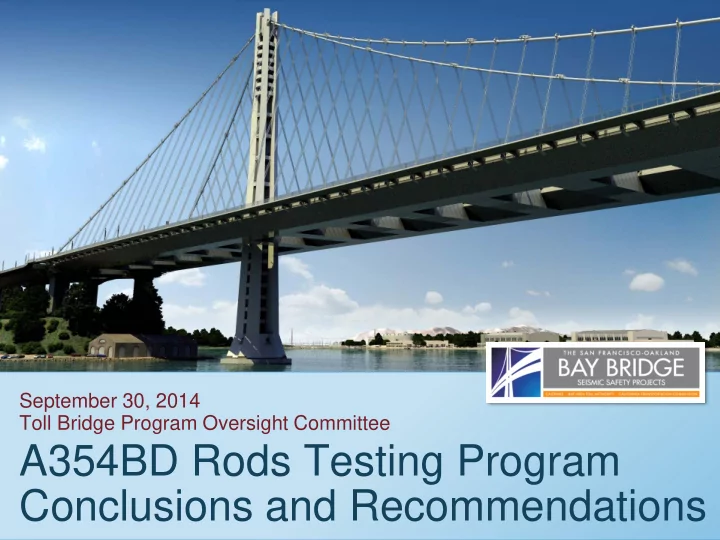

September 30, 2014 Toll Bridge Program Oversight Committee A354BD Rods Testing Program Conclusions and Recommendations 1 Tuesday 9/30/2014
ASTM A354 Grade BD Rods Across SFOBB-SAS 2 Tuesday 9/30/2014
A354BD Rods at Pier E2 — Break Locations 2008 — Location 2010 — 48 Rods of Breaks 2010 — 24 Rods March 2013 24Rods 3 Tuesday 9/30/2014
Testing Program Summary TEST TEST NAME TEST PHOTO TEST PURPOSE AND DESCRIPTION NO. Hardness is a factor known to affect the stress corrosion cracking susceptibility of high strength low alloy steels. Therefore, to evaluate stress corrosion cracking susceptibility of the A354 BD rods in service, it is necessary to measure and characterize the hardness of the in-situ rods and bolts. Field Hardness Test I (in-situ) Test I is an in-situ hardness test on all accessible A354 grade BD rods and bolts on the Self Anchored Suspension Span. Measurements were then taken across the rod or bolt diameter using an ultra sonic contact impedance hardness tester. 1. Laboratory hardness is performed as a verification of the field hardness measurements in Test I. Laboratory Tests: 2. Toughness (Charpy V-Notch) testing and determining the chemical composition are to characterize the material. II Hardness, Charpy, and Chemistry The test specimens were either cut from the stick-out of installed rods or they were cut from spare rods that were manufactured in the same lot as the rods being evaluated. This test is to verify the full-diameter tensile capacity of A354BD rods and bolts vs. typical reduced size tensile test results. Full-diameter specimens are tension tested in a laboratory and supplemented by laboratory testing for: reduced size tension test; Rockwell C hardness; III Full Size Tension Test toughness (Charpy V-Notch); and chemistry, as well as fracture surface examination and analysis. Test specimens were either extracted from the structure (after analysis confirmed that the capacity of the connections were still acceptable), or from spare rods that were manufactured from the same lot as the rods being evaluated. Using full-diameter samples, the stress corrosion cracking thresholds are established for A354BD rods from different material heats and manufactured by different methods. Test IV (Townsend Test) is an accelerated stress corrosion test modeled after the earlier Townsend studies (1975 publication). Full Diameter Rod Stress IV Corrosion Test The testing is as follows: full diameter rods are installed in specially designed and fabricated test rigs that include environmental chambers used to (Townsend Test) submerge threaded parts of the rod. The applied load is increased incrementally by means of hydraulic jacks and held at each step for 48 hours up to a maximum load of 0.85Fu. In the event the rod does not fail at the maximum applied load (0.85Fu) after being held for 140 hours, the rod is pulled to fracture. Extensive post-fracture testing is performed in laboratory. Using small threaded specimens, the stress corrosion cracking thresholds are established using a proven accelerated incremental step load test Small Specimen Stress method for comparison with the Test IV results and for use when larger samples for Test IV are not available. Test V follows ASTM F1624/F2660 V Corrosion Test protocol that establishes a procedure to measure the susceptibility of steel to hydrogen-induced failures. It does so by measuring the threshold (Raymond Test) stress intensity factor for the onset of subcritical crack growth using standard fracture mechanics analysis on irregular-shaped specimens such as notched round bars and actual threaded rod specimens. Small Specimen This test is to validate the stress intensity factors computed in Test V using very slow step loading rates and a sustained load test. The test Additional Verification includes: (1) A long term (5,000 hours) sustained tests in an environmental chamber similar to Test IV and Test V. The test will be performed at VI Testing @ Reduced Load three sustained load levels: (a) at the threshold determined in Test V, (b) at 10% above the threshold, (c) 10% below the threshold. 4 Tuesday 9/30/2014 4 Rates (2) Stepped load testing on Test V size specimens at reduced load rates (halving the threshold rate) to verify the threshold. Tuesday 9/30/2014 (Gorman Test)
Test IV — Townsend Test Results 5 5 Tuesday 9/30/2014 Tuesday 9/30/2014
Test V — Raymond Test Results 6 6 Tuesday 9/30/2014 Tuesday 9/30/2014
Applied Loads, EHE Thresholds and Rod Capacity with Supplemental Barrier 7 7 Tuesday 9/30/2014 Tuesday 9/30/2014
Conclusions The 2008 rods on E2 failed by EHE because they were tensioned above their HE threshold while simultaneously immersed in water, which served as the source of hydrogen. The Townsend Test performed on the 2008 rods in salt solution and in the dry confirmed that without the presence of water, these rods would not have failed. All remaining A354BD rods on the SAS exhibit HE thresholds that are higher than their pre-tension stress levels and are safe. With the specified supplemental corrosion protection, the capacity of A354BD Rods will be at least 1.0 Fu. 8 Tuesday 9/30/2014
Recommendations Nothing further is needed to ensure the integrity of the SAS galvanized A354BD rods that have a supplemental corrosion barrier. A supplementary corrosion barrier to the Pier E2 top housing shear key and bearing rods should be provided. Application of customary maintenance procedures for the galvanized A354BD rods shall be specified in the SAS Maintenance Manual. 9 Tuesday 9/30/2014
Recommendations (Continued) 10 Tuesday 9/30/2014
Recommendations (Continued) The presence of water was recently reported at the bottom of the tower at the shanks of the A354BD anchor rods. • The source of this water shall be fully investigated and addressed in order to prevent potential long term corrosion. • This is not a stress corrosion cracking issue, as the rods are pre-tensioned to levels that are lower than their hydrogen embrittlement threshold. 11 Tuesday 9/30/2014
Applied Loads, EHE Thresholds and Rod Capacity with Supplemental Barrier 12 12 Tuesday 9/30/2014 Tuesday 9/30/2014
Recommend
More recommend